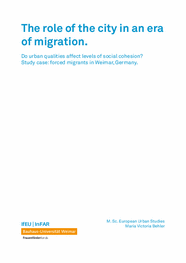
City, Migration & Cohesion
Master Thesis by Maria Victoria Behler
Study Programme Integrated Urban Development & Design
2019
In this Master Thesis Maria Victoria Behler investigates the role of urban form on social cohesion among immigrants in Weimar.
As the era of migration forms part of urban reality strong challenges facing multiculturalism are on the urban agenda. Societies, and in fact cities have become heterogeneous and the response of urban planning to it has remained with a lack of a long-term perspective. Cities concern is not limited to housing or temporary asylums, but is rather a matter of qualities that enhance positive social behaviors.
Public discussion available about refugees and integration into new communities is latent and conflicts between newcomers and hosting communities are unfortunately on the daily basis. A lack of emotional connectedness and common objectives towards future good for everyone is one of the major links missing. In social research, we can termed this missing links social cohesion.
Social cohesion and multiculturalism in cities is the main interest of this thesis. In a context where sociological aspects of integration have been broadly discussed, we inquire what do the city adresses when multiculturalism appear. Can cities influence social behaviors that encourage the construction of a harmonious and peaceful societies of multiple identities which work together towards common good?
The approach of this research has been to quantify social behavior and spatial configurations related to social cohesion according to literature available. As the focus of this research is on migration and multiculturalism, the evaluation has been done among people with forced migration background (refugees), specifically in Germany due to the polemic this topic has generated between the citizens as hosting community, and the difficulties of newcomers for assesing a sucessful integration.
Research available have recognized on one side Physical factors (spatial configuration) of social cohesion, and on the other side Non-Physical (social behavior) factors which influence social cohesion. The Non-Physical factors evaluated in this research concern sociological aspects: Social relationships, Connectedness and Orientation towards common good, each of them with its sub-dimensions respectively. All of them have been evaluated and quantified under a voluntary questionnaire. The Physical factors which talk about urban qualities of space, evaluate the following qualities: Density, Land Use, Accessibility, Connectedness & Permeability, Legibility, Attractiveness, Extent of natural surveillance, Inclusiveness and Maintenance. Each urban quality has been designated by a measurement method based on existing literature and evidence.
Previous evaluation of social cohesion and social behaviors in a similar method showed that no direct relation can be evidenced between urban qualities and behaviors that enhance positive social outcomes. However similar, our finding agrees on the fact that no direct relation can be found but rather the focus on specific characteristics of the urban space have shown correlations that allow for assuming behavior tendencies.
Different to other results, the present research provides a detailed evaluation of each Non-Physical factor and its interconnectedness to each urban quality dimension (Physical factor) taken into account. Findings provide clues for further research in this topic which show relevance. In fact, the focus on facilities, extent of natural surveillance, attractiveness and maintenance indicates sub-dimensions that are worth it to observe in a greater context.This paper allows for new inquires as the influence and comparison in different cultural contexts, considering that social cohesive behaviors just as much as urban qualities perceptions can vary depending on the user’s background.

